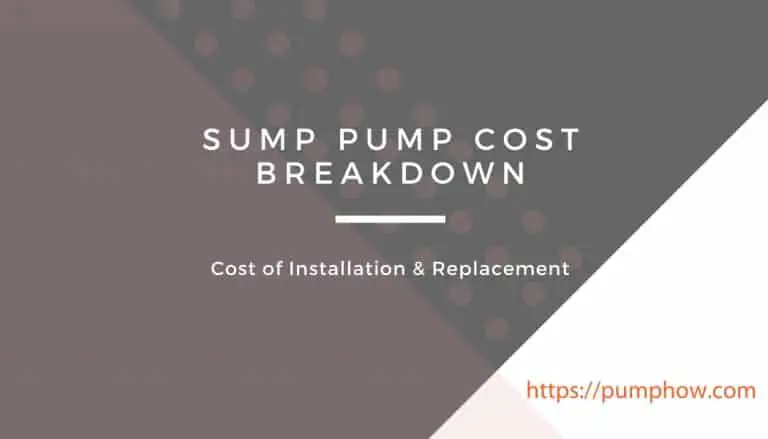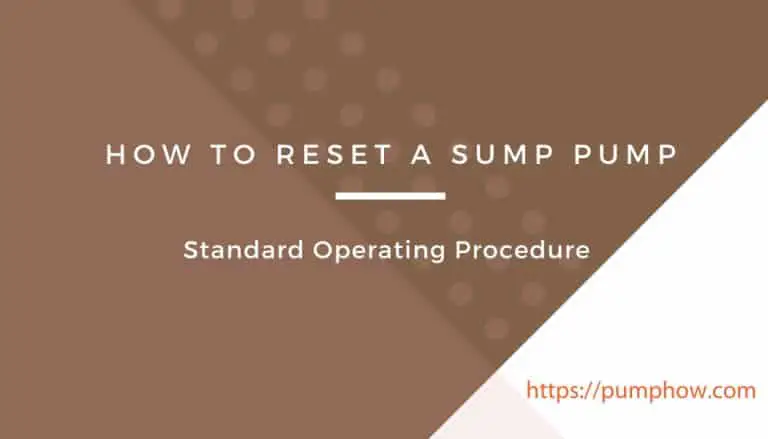If your home has a wet basement, it’s already a home to bacteria, mold, and some harmful organisms, or you won’t have much time before it becomes their breeding ground. Needless to say, the next flood will be a devastating one. Maybe, you’re aware of these dangers. Even, you may know that getting a sump pump is the right thing to do.
What if you need to install one right away? The cost of hiring a plumbing expert for the installation is often higher than that of the pump itself. It certainly makes sense if you can do it yourself.
However, odds are good that you’ll interfere with the emergency utility lines if it’s the first time. So, we’ve brought you a comprehensive guide on how to install a sump pump so you don’t end up losing more than saving.
Pre-Installation Checklist
Doing the following tasks doesn’t mean you’re already on the job. The list below is just a start and indicates when you can get into the core part.
- Foundation
- Drainage System
- Location
- Building Codes and Laws
- Personal Safety
The Foundation
In America, a lot of homes, especially the ones built over the previous 3-4 decades, include gravel foundations under their concrete floor to compensate for any inconsistency during the excavation procedure.
It’s in the nature of water to follow the way where resistance is minimum and move sideways before going up. So, moisture trapped under the floor moves through the gravel beneath the foundation and find its way to a sump pit prior to hitting the floor.
But, how can you tell if a gravel bed is in place on which your basement is floating? In practice, you can’t, but a little help from the builder or a knowledgeable neighbor might come handy. With some experience in drilling concrete, you can take up a hammer drill and bore a few holes to discover if gravel exists.
The basement floor of many buildings constructed over the last decade often has a pit complemented with a drainage-tile set up to direct the water right to the sump pit. If your home has one, you won’t have much to worry about the foundation.
Drainage System
A basement with water problems doesn’t always indicate that it’s the only place you should look. A lot of people may disagree, but the drainage setup is mostly responsible. So, check everything in your home’s outdoor drainage system.
- Check the gutters for clogging, leaves, debris, and anything that block them.
- Inspect the downspouts and see if they can carry the unwanted water so far away that the water cannot travel back. The downspouts should be able to cover at least 4-5 feet of distance.
- Check the soil around the foundation to ensure that it slopes around 1 meter away from your house.
- Inspect all the pits properly to see if they hold the water and push it downward. If that happens, fix them before getting a pump installed.
Location
Choosing the right location is critical to a successful installation because a poor choice might lead to an unspeakable danger. Locate the bottom of your crawl space or basement because that’s where the pump should sit. Make sure you can create a downward slant to prevent water from settling in the event of flooding.
- You can look for a wall in your basement to put the pump near there because the discharge has to get out of your basement and stretch 10-12 feet outside.
- Identify a spot where it’s comfortable to work in. Since you’ll want to reach outside, the spot should allow you to make a hole easily through a rim joist.
- Try to stand 8-9 feet apart from your foundation wall because you don’t want to hit the footings.
- Choose a surface that is flat and hard.
Here’s another crucial consideration. The pump needs to be close to an exterior wall that has an electrical outlet, preferably a GFCI outlet to ensure that the circuits don’t blow accidentally. If this convenience doesn’t exist, you can have an electrician install it.
Building Codes
It’s not a rare incident for many to forget about the building codes. But, the consequences aren’t strange at all. Like all municipalities, yours has introduced specific building codes and zoning laws that determine whether or not you can do certain things concerning your residence.
There’s no doubt that you do have the freedom to exercise when it comes to your home, but you can’t do anything that may affect the neighbors and the neighborhood. Sometimes, an incorrect or careless installation may cause serious damages to your lifestyle and more importantly your property. After all, a few minutes of reading won’t hurt.
You’ve got to be careful about a few things. First, locate the utility lines (sewer, water, etc.) and mark them clearly; so you can avoid breaking through them, especially the water lines, while digging into the concrete floor using the brute force of a drill machine.
In case you can’t locate the service lines, you should ask the local authority for the required information. Odds are high that the measurements had been recorded during the installation of the pipes. These lines under your home come right from the street covering a distance of 4-6 feet from the municipal’s sewer pipe.
Safety Clothing and Gear
Safety can’t be optional, you know, especially when you’ll have to use tools like a saw, hammer, shovel, etc. Luckily, you don’t need any special gear. Just the typical work gloves, goggles, and boots will be okay. Most homeowners have these items in their collections.
Submersible or Pedestal?
Both types are sold in abundance. Submersibles operate almost quietly and are kept hidden inside the pit. The motor of a pedestal pump isn’t concealed as it’s kept above the water, and it’s the louder yet more affordable one. Read the details on another page.
In this article, we’ll discuss the procedure separately for each type so that you can do exactly what is required by your particular type.
5 Steps to Install a Submersible Sump Pump
Each step is indispensable to the whole procedure. Try to stick to them as suggested below.
Things You Need
- A submersible pump
- A drill machine
- A jackhammer/sledgehammer
- A Bucket (plastic/fiberglass)
- PVC pipe with fittings
- Pit liner
- Marker
- Tape and glue
- Cement
- Gravel
- Caulking
1. Build the Pit
Dug in the basement, a hole is needed for holding the pump and its liner. Keep the pit at least 8 feet apart from the foundation edges and the walls of the basement. Here’s how things should get going.
Find the Pump’s Measurements and Plan the Pit
Check the product’s packaging or user manual and find the product measurements on the list of specifications. You can also find it on the manufacturer’s website. The hole needs to be at least 10″ wider and 6″ deeper than the pump.
Start Digging
- Mark the specific area of the floor (to be removed) leaving at least 6″ around the sump pit.
- Cut the whole perimeter using the jackhammer.
- Slice through its interior in bites that measure 8″-12″.
- Use the jackhammer and loosen some flooring pieces.
- Collect the rest of the concrete chunks and use the bucket to carry/collect them away.
Remember excavating so much soil as you can use 6 inches of gravel around the sump liner. Check to see if the liner’s top is parallel to the floor top. If it is, you’re good to move onto forming the base.
Attention!
Keep the door and windows close to your basement open so that the amount of dust can be minimized inside the home.
Make the Base
Before you place the liner, use 3-4 inches of gravel to fill the pit’s base. Use a wooden base right on the gravel’s top to make sure the pit’s bottom is level.
Place the Pit
It’s time to insert the liner into the hole you just dug. Pour some coarse gravel all around it. Gravel with 3/8″–1/2″ in diameter is appropriate in this case. The liner includes some openings on its halfway from its rim, which allow the liquid to enter and help start a submersible pump.
Do the Leveling and Smoothing
If the floor is 4″ thick, try to put enough gravel so that the grade gets 1″ above the floor’s underside and 3″ below its top surface. Use a wooden float to level and trowel the gravel.
2. Install the Pump
- Find the pump’s discharge port and put a 1.5″ PVC male adapter carefully inside that port. Then, fasten/secure it using pliers.
- Use cement and glue to keep the adapter okay in place.
- The sump pump riser should rest a little over the liner’s top.
- Attach the cables to that riser with the help of tape.
3. Place the Pump inside the Liner
- Put the pump gently into the liner by holding its handle and the riser.
- Make sure the pump sits properly on the base.
- Check if float switch moves without any obstacle and doesn’t stay very close to the liner.
- Place the cover of the liner above the pump’s riser.
4. Install the Check Valve
Some of the benefits of a check valve are that it helps protect the motor from burning out or overheating and prevent water from going down into the sump pit even after getting pumped out. You’ll have the valve with hose clamps and rubber couplings. Here’s how to install.
- Position that valve with a specific arrow, the one that points up, and indicates the direction of the flow.
- Use a nut driver or screwdriver to tighten the coupling (the lower one) over the riser.
- Get another riser section right above the check valve. It needs to stretch into the middle of the ceiling joists of the basement.
- With the help of a hose clamp, secure the additional riser to the valve’s upper coupling.
Attention!
Try to figure out the horizontal run out of your house in order to determine how long the additional riser can be.
5. Set up the Discharge Line
- Create a hole from the basement’s ceiling joist to its outer wall.
- Make sure the diameter of the opening is ¼″.
- Push the PVC pipe carefully into the joist letting it stay near the riser from the pump.
- Use an elbow joint appropriately to the drain pipe. Inspect the riser’s position prior to its attachment with the discharge line.
- Move outside to create an opening. It should be ½″ from your horizontal pipeline which goes through the siding.
- Apply glue to secure the elbow to the downward end of the pipe.
- Use caulking to line the joist opening’s sides. This way, it’ll be water-resistant.
Thus, you can install a submersible sump pump correctly. Let’s see how to install a pedestal pump without mistakes.
5 Steps to Install a Pedestal Sump Pump
This type of pump remains partially hidden, which is why its installation involves approaches that are a little different from those for a submersible.
Things You Need
- A pedestal pump
- A hole saw and a hacksaw
- A drill machine
- A sledgehammer
- A shovel
- Concrete and cement
- Gravel
- Caulking
- PVC pipes with elbow joints
- A Marker
1. Start Digging
- Tip the line of the sump basin upside down.
- Lay out the portion (to be drilled) using the marker.
- Use the sledgehammer or jackhammer to do it.
Attention!
Follow the same precautions as the ones during the installation of a submersible.
2. Install the Pit
Now that you know how to install a pit for a submersible pump, you won’t see so many differences while doing this particular task. Slight deviations in the measurements won’t be a big deal in this case.
3. Set up the Discharge Line
- Before the concrete gets completely dry, try to make some space for your discharge line.
- Use the PVC pipe to secure the line to the valve and connect the PVC pipe along with the check valve to the pit.
- Bring the pipeline carefully up the full length of the wall.
- Use the hole saw to create a hole to get the pipeline easily through the opening of the wall.
- Use an elbow joint to connect the pipe properly in the discharge hole.
- Use caulking to seal the pipe’s outer and inner parts and make them water-proof.
4. Place the Submersible Pump inside the Sump Pit
- Put the pump on the pit’s outer part.
- Consult the manual to check if anything is wrong with the installation. Ensure that the float switch doesn’t touch the pit walls as you put the pump.
- Make sure the pump stands level on the floor by bringing it down into the sump pit.
5. Connect the Pipe to the Discharge Pipeline
A PVC pipe is required to make a connection between the pump and the discharge line. Find out the exact length of that pipe. Then, use the hacksaw to get the required length. Use cement to attach it to the adapter.
And this brings us to the end of the process for a pedestal sump pump. But, you should go an extra mile to know if things have been done perfectly.
Two Additional Steps to Complete Both Installations
Some homeowners don’t take these steps very seriously as the actual installation isn’t influenced by them. However, they make sense, and this is how.
Test the Pump
Won’t you see if your efforts were useful at all? Testing the pump’s functional state will let you know for sure. For this, you’ll have to check if the pump activates and the float switch functions.
First, keep pouring water into the pit until it becomes full. Then, notice the activity of the switch as well as the pump. You may feel relaxed if it runs properly and its cycling pattern is okay.
After that, you should go outside to check the discharge drain. Water should keep going off smoothly through the discharge lines.
Use a Sump Pit Cover
It’s not uncommon to see that sump pits in many houses are left without any cover or sealing arrangement. This may cause unforeseeable yet serious issues.
An uncovered pit may allow soli gases like radon and other harmful elements to get their way inside the crawlspace/basement and cause the indoor air quality to get contaminated. So, you can cover your sump pit using an airtight lid or gas-tight cover to prevent any potential issues.
Dos and Don’ts
You may have understood that there’s every chance for you to get something wrong throughout the process. Follow these tips to avert any unnecessary risk or outcome during/after the installation.
- Read the installation or user manual that comes with your sump pump.
- Inspect the pump for visible defects/damages (if any).
- While handling the pump, keep it disconnected from its power source.
- Avoid any extension cord that doesn’t meet the sump pump manufacturer’s requirements.
- Have a filter membrane installed around the sump’s liner or under a bottomless liner. The filter should protect the pump from collecting sediment.
- Avoid using the power cord to carry the pump.
- Prepare the sump pit in a way that it becomes spacious enough to allow the float switch to have the required clearance.
- Make sure the discharge pipe of the pump isn’t bigger than the one for the main discharge line.
- Don’t drop chemicals like degreasing agents, harmful acids, paints, floor wax, etc. into the pump.
- Get rid of any debris that might accumulate in the sewage pit. The presence of too much debris may obstruct the initial start-up of your pump.
Once you’ve completed your part; there remains another important part to it – the drain system. But, that’s another story, and we’ve explained it in another discussion. If you want to clarify anything from the above description, feel free to let us know via email or message.







